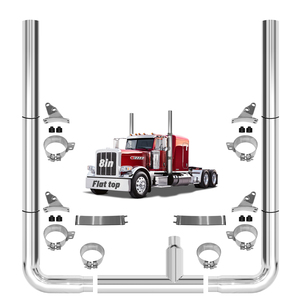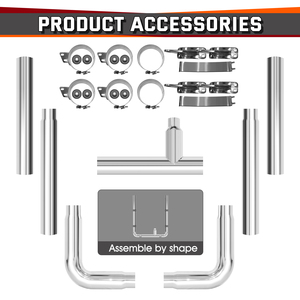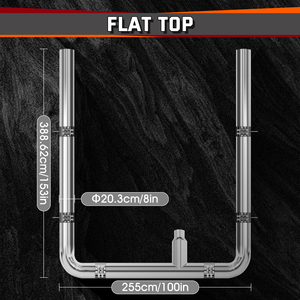(18 products available)
























































































A header is a device attached to the top of a car's exhaust port cylinder. It is one of the most important parts of a car's engine. Its basic function is to allow exhaust gases to leave the combustion chamber. Flowtech headers are performance headers that improve the performance of car engines.
There are two main categories of Flowtech headers:
Flowtech headers possess various specifications that enhance their performance and durability. Below are some of the key specifications of Flowtech headers:
Durable construction:
Flowtech headers are constructed from strong steel material. The steel is coated to prevent rusting and corrosion. The headers are also constructed from strong and durable welds.
Tube diameter:
Flowtech headers have large tube diameters. The diameter of the tubes ranges from two inches to three inches. The large tube diameter improves airflow and reduces back pressure.
Collector size:
Flowtech headers have large collector sizes. The headers' collector sizes range from two and a half inches to four inches. The large collector size allows for better exhaust flow.
Port shape:
The Flowtech header has a square port shape. The square ports offer a better seal between the header and the engine block.
Bolt hole alignment:
Flowtech headers have a standard bolt hole alignment. This ensures that the headers can be easily installed on various engine types.
Heat resistance:
Flowtech headers are designed with heat-resistant material. The material can withstand high temperatures without warping or damage.
Below are some of the important maintenance practices for Flowtech headers:
There are some factors that need to be considered when choosing Flowtech headers for vehicles.
Application
Consider the intended use of the vehicle. Is it primarily for street use, or is it a track car, or do they need headers for off-road use? Different applications may benefit from different header designs and materials.
Engine Size and Type
Consider the vehicle's engine size and type. Flowtech headers are designed for specific engine sizes and types (such as V8, V6, or inline-4). Ensure that the headers match the engine specifications to achieve optimal performance gains.
Material
Flowtech headers are usually made from stainless steel, mild steel, or other metal alloys. Stainless steel headers are more resistant to corrosion and can withstand higher temperatures, making them a long-lasting choice. On the other hand, mild steel headers are affordable and offer good performance gains. Choosing the right material depends on the budget and the desired level of durability.
Design
Consider the header design. Long tube headers offer the most significant performance improvements by reducing exhaust backpressure and increasing exhaust flow. Shorty headers are a more affordable option and are easier to install, making them a practical choice for streetcars.
Collector Size
The collector size of Flowtech headers plays a crucial role in exhaust flow and overall performance. A larger collector size can improve performance in high-power applications, while a smaller collector size may be suitable for everyday street use. Choose a collector size that aligns with the vehicle's intended use and power requirements.
Vehicle Compatibility
Not all Flowtech headers will fit every vehicle. Ensure the selected headers are compatible with the vehicle's make, model, and year. Some headers may require additional modifications or come with specific adapter kits for precise fitment.
Sound Level
Consider the desired exhaust sound level. Headers can significantly affect the exhaust note, and different designs may produce varying sound characteristics. If sound is a concern, research header reviews or listen to sound clips before making a decision.
Legal Compliance
Check local regulations regarding emissions compliance and noise levels. Some headers may be designed to meet emissions standards, while others are intended for off-road or racing applications where emissions compliance is not required. Ensure the headers chosen are legal for the specific application and location.
Budget
Flowtech headers are available in various price ranges. Set a budget and consider the long-term benefits of performance gains, fuel efficiency, and potential durability when choosing headers. Consider the overall value rather than just the initial cost.
It is advisable to always get a professional to install Flowtech headers for a better experience and to avoid damages. However, it is possible to install them as a DIY project. Before starting the project, ensure that all the tools needed for the job are available. The tools needed include a jack and jack stands, ratchet and socket set, combination wrenches, torque wrench, screwdriver set, allen wrench set, pliers, pipe cutter, hacksaw, hammer, rivet gun, pop rivets, and safety glasses.
Begin by lifting the front of the car and securing it with jack stands. Remove the old factory-installed exhaust manifolds and the associated gaskets and bolts. This should be done carefully to avoid damaging the car. Next, install the Flowtech headers by positioning them properly and securing them with bolts. Make sure they are properly aligned to avoid damages when the car is in motion. After they are properly aligned and fitted, the bolts should be tightened securely. Once this is done, the headers should be connected to the exhaust pipes. This can be achieved by using the provided exhaust pipes and flanges or by welding the headers to the existing exhaust system.
Finally, check for any leaks or clearance issues and make necessary adjustments. Once everything is done and the changes have been reflected, the car can be lowered, and the hood can be closed.
Q1: What are flowtech headers?
A1: Flowtech headers are tubular exhaust headers designed to replace the stock exhaust manifold on a vehicle. They are engineered to improve exhaust flow, reduce backpressure, and enhance overall engine performance.
Q2: What are the benefits of Flowtech headers?
A2: Flowtech headers offer several benefits, including increased horsepower and torque, better throttle response, improved sound, and enhanced durability compared to stock manifolds.
Q3: Can Flowtech headers fit any vehicle?
A3: Flowtech headers are available for a wide range of vehicles, but compatibility depends on the specific make, model, and engine type. It's essential to choose headers designed for the particular vehicle to ensure a proper fit and performance gains.
Q4: Do Flowtech headers require any modifications for installation?
A4: While Flowtech headers are designed for a direct replacement of stock manifolds, some vehicles may require minor modifications or additional components (such as O2 sensor extensions or heat shield modifications) for a proper fit and installation.
Q5: Do Flowtech headers come with a warranty?
A5: Many Flowtech header products come with a manufacturer's warranty, covering defects in material and workmanship. The warranty duration may vary, so it's essential to check the specific terms and conditions provided by the manufacturer.